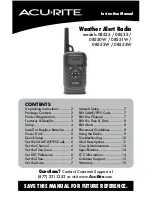
18
In practice, even omni-directional antennas take advantage of directionality by
focusing their sensitivity and power in the horizontal plane. Rather than waste
performance by sending signals into space or into the ground, the horizontal
omni-directional antenna redirects its power and sensitivity from these directions,
increasing performance in the horizontal plane.
In point-to-point applications, where the direction of communication is known and
fixed, a highly focused directional antenna can be used to provide maximum
sensitivity and power. In addition, because of its decreased sensitivity in all directions
but the desired one, the directional antenna improves performance by rejecting
signals not coming from the desired direction. This provides an effective increase in
signal-to-noise performance.
A sector antenna has a wider “spread” than a directional (generally between 60 to 120
degrees) which makes it a cross between an onmidirectional and a directional. This is
useful in a point to multipoint configuration where multiple sites are grouped in the
same general area. The installer can then make use of the higher sensitivity and
power but also take advantage of the wider beam pattern and improved front to back
ratio.
Gain
“Gain” specifies the receive and transmit performance of any antenna compared to a
standard omni-directional antenna (“spherical radiator”). The objective of a directional
antenna design is to achieve gain, improving sensitivity and effective radiating power to
increase range or data rate.
Gain is measured and stated in decibels, abbreviated dB. The decibel is a unit used to
indicate the relative difference in power between two signals. For example, a signal 3
dB greater than another signal has twice as much power. The decibel is a logarithmic
unit so each doubling of decibels represents a fourfold increase in power. Since 3 dB
represents a doubling of power, 6 dB represents a fourfold power increase, 12 dB
represents a 16-fold increase, etc. For antenna performance, the unit used is dBi, “i”
standing for “isotropic,” which describes the standard spherical radiation pattern.
One type of directional antenna available from Wireless Interactive is called a “semi
parabolic”. This antenna has a gain of 24 dBi, representing power and sensitivity
levels 256 times greater than those of a standard omni-directional antenna.
Polarization
Another important concept for antenna performance is polarization. An antenna
radiates radio waves that vibrate in a specific plane, normally horizontal or vertical.
Polarization refers to the restriction of wave vibration to a single plane.
Do
not
confuse polarization with directionality. The plane of wave vibration
has nothing to do with the direction of wave propagation. For example, an
antenna that focuses its energy in the horizontal plane may be vertically or
horizontally polarized.
Designs such as the semi parabolic offer a choice of polarization. Mounting a semi
parabolic antenna with the elements horizontal provides horizontal polarization, while
mounting the antenna with the elements vertical provides vertical polarization.
Similarly, the orientation of the radiating element of the parabolic antenna determines
polarization.
















































